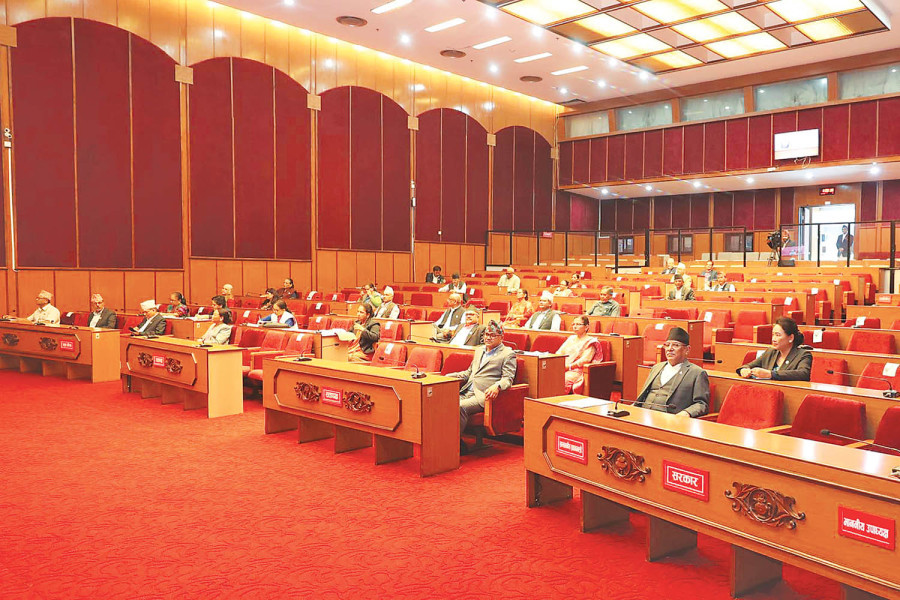Columns
National Assembly reflections
Parliament is where a goat’s head is shown and a dog’s meat is sold.
Khim Lal Devkota
The National Assembly, also known as the upper house of Nepal’s federal parliament, is set to bid farewell to its 20 members, including myself, on March 3. Our six years in office are coming to an end, coinciding with the completion of a six-year tenure for the Assembly. For those elected for the first time, terms of two, four and six years were determined by a lottery system. The terms of a third of the members expire every two years, leading to a renewal through an election process and presidential nomination. The new members have already been elected on January 25 and will formally take the “oath of office” on March 4. By-elections will be held to fill the remaining members.
The Assembly is comprised of 59 members, 56 of whom are elected from provincial Assembly members and local government representatives—eight each from the seven provinces. The President nominates the remaining three members.
Ups and downs
The House of Representatives was dissolved on May 22, 2021, before our formal oath as members of Parliament on May 28. This incident disappointed the newly elected Assembly members. My frustration was that I would address issues, such as citizens' expectations and the problems subnational governments faced, in Parliament but that opportunity was denied.
The government introduced the budget on May 29 that year, bypassing the permanent parliamentary entity—the Assembly. It was announced in the National Planning Commission chamber as an ordinance. Had the government wished, it could have presented the budget in the Assembly. Had the constitution stipulated that the Assembly would undertake the responsibilities in the absence of the House, perhaps numerous comments and criticisms regarding the essence of the Assembly would not have arisen.
As per Nepal’s constitution, the time gap between two Parliament sessions should not exceed six months. Consequently, a meeting of the Assembly was convened on July 1, 2021, which lasted only five days. The Covid-19 pandemic also impacted Assembly and committee meetings.
My first deliberation took place on July 5. Surprisingly, the new map of Nepal showing the geography of Kalapani, Limpiyadhura and Lipulek, and the revised constitution, were not available on any government website, including the Parliament's. Corrections were subsequently made.
After the reinstatement of the House on July 12, 2021, meetings of both the House and the Assembly were convened, but they were relatively brief. At that time, the Supreme Court mandated the appointment of Sher Bahadur Deuba as the prime minister. The Deuba government issued an ordinance to facilitate the split of political parties. This split the Nepal Communist Party, causing disruptions in the House meetings for approximately six months and making it impossible to engage in parliamentary discussions.
The Assembly serves as the representative entity for both provincial and local levels. If the voices of the subnational levels are not heard by the Assembly, who else will? This perspective prompted me to propose a resolution regarding the implementation of federalism. Under my leadership, a “Federalism Implementation Study and Monitoring Parliamentary Special Committee,” comprising seven members representing all political parties, was formed on June 3, 2021. After a series of discussions and consultations with stakeholders, we submitted the report to the Assembly. The government has now accorded high importance to this report, with the prime minister consistently referencing its significance. The conference meeting of the Speakers of the federal parliament and provincial assemblies has also decided to coordinate and facilitate the implementation of this report.
I currently represent the “Legislative Management Committee” at the Assembly. During my first year, I was a member of the “Delegated Management and Government Assurance Committee.” While serving there, I gained insights into irregularities in implementing delegated legislation, referred to as secondary laws, including rules, regulations, orders, etc.
Chaos and disorders
Through research during that time, I uncovered that the law-making process in Nepal is chaotic and lacks proper rules and procedures. Observing the disorder within delegated management, Assembly members including Radheshyam Adhikari, Ram Narayan Bidari and myself, approached the government numerous times, calling for the legislation related to this issue. We emphasised the need to address concerns such as ensuring citizens' involvement in law-making. As a result, the government introduced a bill related to drafting of laws. After it was tabled in the Assembly, the bill was subsequently approved and forwarded to the House.
I participated in discussions on about two dozen bills, including those originating from the House. While in the Legislative Management Committee, I observed that most government bills are centralised and disregard subnational-level jurisdiction. Similarly, I learned that self-interested groups heavily influence the drafting of bills in Parliament. Many ministries’ plans and programmes appeared to violate the jurisdiction of provincial and local levels. Many programmes and projects discussed in Parliament were related to the constituencies of influential political leaders and ministers. I consistently raised questions, highlighting the unfair distribution of the state’s financial resources.
In my observations, ministers often lack a sense of accountability to Parliament. It is where a goat’s head is shown and a dog’s meat is sold, as Parliament is generally criticised as a forum of political deception. Over time, I believe I have come to understand the politics of Nepal. In a short period, most of what I tried and did aimed to ensure the rights of provincial and local governments, thereby helping with the institutionalisation of federalism.




 7.12°C Kathmandu
7.12°C Kathmandu















